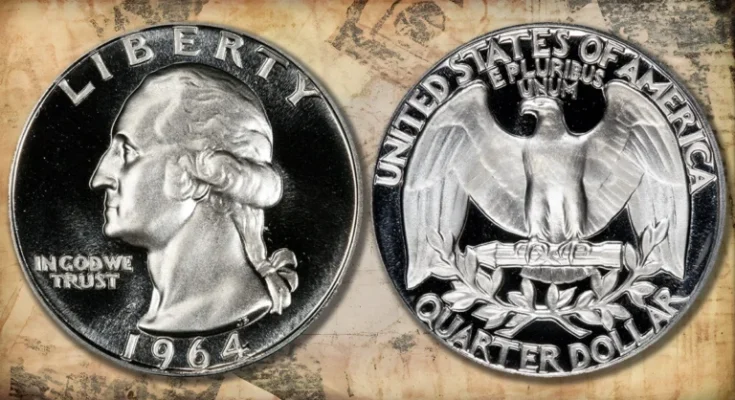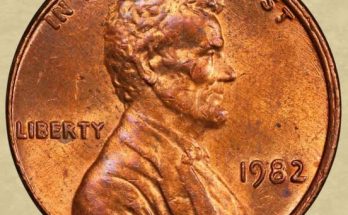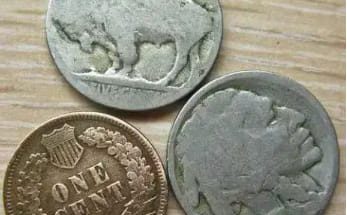1964 marked the end of an era in United States coinage, and not just for Proof issues like the 1964 Washington Quarter but for all silver coins struck for circulation.
The dime, quarter dollar, and half dollar would all see their metal compositions changed, with only the half dollar retaining some semblance of precious metal – and then only through the end of the decade.
The Washington Quarter and Roosevelt Dime would be debased completely, with issues dated 1965 and beyond consisting of a sandwich metal composed of copper and nickel.
With 3,950,762 sets sold, the 1964 Proof Set established sales records and capped a decade-long trend of speculation and bulk buying. The United States Mint had sold three million sets in each of the three proceeding years, but public sentiment following President Kennedy’s assassination and the Treasury Department’s quick adoption of a new coin to memorialize him undoubtedly contributed to the high sales. Speculators doubled down on this organic demand, seeing the issue price of $2.10 as a low-cost-of-entry investment with huge potential upside.
The U.S. Mint, overwhelmed with demand for not only its Proof sets–which took extra time and care to produce–but also its circulating coinage, would take a number of measures at the end of 1964 and the beginning of ’65 to reaffirm its mission to produce coins for the economy, and not for the pleasure of numismatists and speculators. While some in Congress saw coin collectors as hoarders who had become a threat to the economy, the Mint saw them as particularly irksome and initiated a number of draconian measures intended to chill demand for modern coin issues. The use of mintmarks was discontinued and a date freeze was instituted. Commerce was flooded with billions of new clad coins while the nation’s silver coinage was rapidly drained from circulation.
An olive branch, the loathed Prooflike “Special Mint Set“, was offered in 1965, ’66, and ’67. These sets, which sold for twice the price of the 1964 Proof Set, trade today for about $8.00. Contemporary collectors saw little “special” about them, and after strong advocacy by the American Numismatic Association (ANA) and the leading numismatists of the period, the Mint resumed its Proof program in 1968, charging $5.00 per set.
The steadily increasing premiums charged for U.S. Mint products would continue to cause major discord within the secondary market of the collecting hobby.
The 1964 set, beyond being the last of the “classic” silver Proof sets of the modern period (1950-1964), was the only Proof set issued with a 90% silver Kennedy Half Dollar. This marks it as a one-year Proof type. Sets issued from 1950-1958 included the Franklin Half Dollar and the Lincoln “Wheat” Cent. Sets issued from 1959-1963 included the Franklin Half Dollar and the Lincoln “Memorial” Cent.
When collectors are looking for the best examples of Proofs from this period, they are looking for grade and the presence of thick, bold frost, and Cameo or Deep Cameo/Ultra Cameo Proof coins struck in 1964 are relatively uncommon. Nevertheless, ’63 and ’64 yielded far more of these frosted coins than any other year during the 1950-1964 run, and the availability of Cameo and Deep Cameo/Ultra Cameo 1964 Washington Quarter Proofs is among the highest of the 90% silver set coins.
The Mint would develop methods of applying Cameo frost to coins in the late 1960s, perfecting said methods in 1978.
What Is the 1964 Washington Quarter Proof Worth?
Regardless of condition, a Proof 1964 Washington Quarter is made of 90% silver and has an actual silver weight of 0.1808 ounces. This means that if silver is $32.44 an ounce, then a Washington Quarter struck before 1964 has a melt value of $5.87.
The numismatic premium for a well-preserved Washington Quarter is worth approximately two times melt, or $10.00.
Coin certification by PCGS or NGC can add significant numismatic value to the coin, especially if the coin exhibits thick cameo frosting and virtually flawless fields and devices. PCGS has certified 37 Brilliant 1964 Washington Quarters as Proof 70, but to date, no Cameo or Deep Cameo has earned higher than Proof 69. A PCGS Proof 70 with great eye appeal will trade for about $300; however, a badly spotted example in an old PCGS holder sold at Heritage in 2017 for $119. That coin sold for about $109 too much.
Brilliant examples in 69 routinely trade for $30. In Cameo, a 1964 Washington Quarter in Proof sells for between $50 to $75. The dividing line between Cameo and Deep Cameo/Ultra Cameo can be arbitrary. A superior Cameo may very well exceed the eye appeal of a run-of-the-mill Deep Cameo, making a stretch buy of $75 to $100 for a PQ Cameo a logical play for the specialist collector.
In Deep Cameo/Ultra Cameo 69, expect to pay between $200 and $300… or more if the coin is truly remarkable. This price is down considerably from the $1,000+ prices this issue realized at auctions in the early 2000s. Not all Deep Cameo/Ultra Cameo coins are created the same; some have just enough frost to earn the designation, while others come blanketed in six feet of it. That latter, exponentially rarer coin, should bring substantially more than prevailing rates of sight-unseen coins in the same grade.
* * *
1964 Washington Quarter Proof Market Data and Noteworthy Specimens
Through November 2024, NGC reports 22,685 grading events of the 1964 Washington Quarter Proof. 6.32% of this total has earned the Cameo designation, while a paltry 1.93% has earned Ultra Cameo. The typical grade for a submitted coin was in the Proof 67 to 68 range, with a sizable population in Proof 69. Assume that coins submitted for grading were handpicked for quality. On average, a fresh, well-cared-for Proof set will yield a quarter in this grade range. Expect worse if the coin was mishandled, the set’s packaging is brittle or damaged, or the coin was removed and put into a Capital holder.
Also through November 2024, PCGS has graded 8,643 1964 Washington Quarters in Proof. From that pool, PCGS has attributed their Deep Cameo designation to 5.67% of coins submitted, while 11.8% earned the company’s Cameo attribution. PCGS’ grade distribution mirrors that of NGC.
That one service’s Cameo and Deep Cameo/Ultra Cameo designation is higher than the other’s (given the relative population size) is interesting but not conclusive. Our assumption is that more coins were submitted in bulk to NGC, regardless of the presence or absence of frost.
That said, based on our observations, NGC’s 1.93% appearance of Ultra Cameos is a little too low and PCGS’s 5.81% is a little too high. A more accurate ballpark is 90% Brilliant, 7% Cameo, 3% Deep Cameo/Ultra Cameo.
Top Population: PCGS PR69DCAM (110, 11/2024), NGC PF69UCAM (118, 11/2024), and CAC PR69DCAM (0:1 stickered:graded, 11/2024).
- NGC PF70CAM #1272080-013: Heritage Auctions, February 14, 2008, Lot 519 – $2,185. Weaker cameo on reverse held this back from UCAM designation.
- PCGS PR69DCAM #71777169: Stack’s Bowers, June 20, 2024, Lot 6433 – $216.
- PCGS PR69DCAM #1559747: Heritage Auctions, June 10, 2024, Lot 54235 – $508.80.
- PCGS PR69DCAM #7814263: Stack’s Bowers, April 12, 2023, Lot 91557 – $144.
- PCGS PR69DCAM #5685387: Heritage Auctions, October 20, 2020, Lot 25765 – $396.
- NGC PF69UCAM #1833932-024: Heritage Auctions, June 30, 2020, Lot 21126 – $408.
* * *
Design
Obverse:
John Flanagan’s obverse design features a left-facing portrait of President George Washington based on the Jean-Antoine Houdon bust of 1786. The word LIBERTY wraps around the top of the coin above Washington’s hair. The date 1964 wraps around the bottom, below Washington’s bust truncation. To the left of Washington is the national motto IN GOD WE TRUST.
Reverse:
A heraldic eagle rendered in Art Deco style is perched atop a sheaf of arrows. The arrows and the eagle’s head are facing left. Two sprays of olive branches form a “U” shape wrapping around the bottom of the eagle. Wrapping around the top of the coin is the legend UNITED STATES OF AMERICA. Below that is the motto E PLURIBUS UNUM. Wrapping around the bottom of the coin, the denomination QUARTER DOLLAR is inscribed.
Edge:
The edge of the 1964 Proof Washington Quarter, like all Washington Quarters, is reeded.
Coin Specifications
| Country: | United States of America |
| Year of Issue: | 1964 |
| Denomination: | Quarter Dollar (25 Cents USD) |
| Mintmark: | None (Philadelphia) |
| Mintage: | 3,950,762 |
| Alloy: | .900 Silver, .100 Copper |
| Weight: | 6.25 g |
| Diameter: | 24.30 mm |
| Edge: | Reeded |
| OBV Designer: | John Flanagan |
| REV Designer: | John Flanagan |
| Quality: | Proof |



